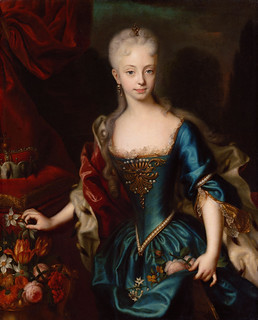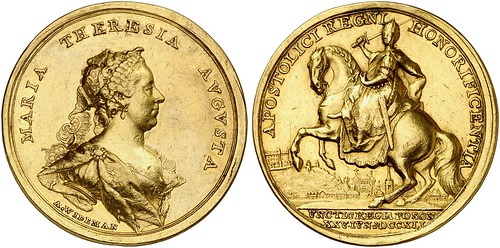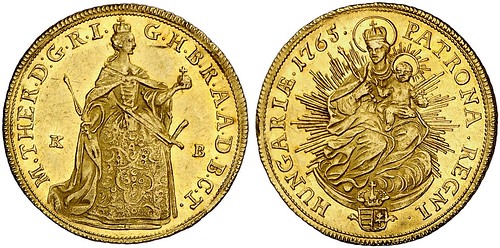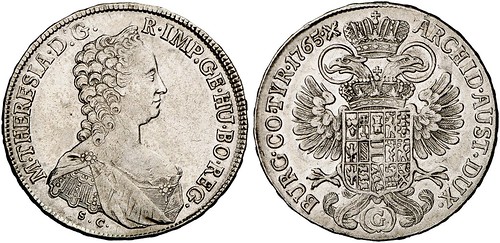
PREV ARTICLE
NEXT ARTICLE
FULL ISSUE
PREV FULL ISSUE
THE COINS OF MARIA THERESAMost collectors are aware of Austrian Empress Maria Theresa (1717-1780) because of the dollar-size silver trade coin that bears her likeness. Yet there are quite a number of other
Maria Theresa coins and medals one can collect. The Künker firm published an article June 3, 2017 featuring several of these from their upcoming sale. Here's an excerpt and a few items that
caught my eye. -Editor
 
Maria Theresa at ages 11 and 60 On 13 May 1717, Maria Theresa was born as the second child of Emperor Charles VI. Her older brother had died shortly after his birth and there would not be any more sons. Therefore it was soon evident that she would be the next ruler of the Habsburg hereditary lands. ... Maria Theresa, the 23-year-old archduchess of Austria, Queen of Hungary and Bohemia, was forced to simultaneously fight against Prussia and Bavaria, Spain, Saxony, France, Sweden, Naples, the Electoral Palatinate and the Electorate of Cologne in order to maintain her country's integrity. 
Maria Theresa. Gold medal by A. Widemann The mints of Maria Theresa
After the Austrian War of Succession and the first two Silesian Wars, Austria's finances were ruined. Maria Theresa thus used an effective method to regenerate. In the 18th century, this method was to lower the silver content of the denominations and to mint more fractions, whose intrinsic value was far below its face value anyway. 
Maria Theresa. Ducat 1765, Kremnica. Maria Theresa actually issued three edicts in just four years: In 1747, she demanded that the minting of talers, half-talers and quarter-talers be limited in favour of fractions, in 1748 and 1750 she reduced the metal content of all coinages. In order for the officials to be able to recognise the "bad" coins, a saltire was put after the year. Of course this "secret mark" did not stay secret for all too long... After Maria Theresa's death, 3,943 gulden and 44 kreuzers were found lying around in Maria Theresa's room, which could be interpreted as a sign that in 1780, when the empress died, the money problems were gone. She left a well-organised empire to her son Joseph II, which he then reformed into a modern state. This state, despite Napoleon, would grow into the multinational empire of the 19th century. 
Maria Theresa. Half-convention taler 1765 The article does not illustrate the "secret mark". Could anyone send us images or cite a reference with more information? -Editor
To read the complete article, see:
 Wayne Homren, Editor The Numismatic Bibliomania Society is a non-profit organization promoting numismatic literature. See our web site at coinbooks.org. To submit items for publication in The E-Sylum, write to the Editor at this address: whomren@gmail.com To subscribe go to: https://my.binhost.com/lists/listinfo/esylum All Rights Reserved. NBS Home Page Contact the NBS webmaster 
|